
Common name:Kangaroo Paws
Botanical name:Anigozanthos flavidus
This tender perennial is a clump-forming evergreen that produces fuzzy, yellow green flowers that bloom in spring and last for over 2 months.

Common name:Weber Agave
Botanical name:Agave weberi
This is a striking medium-sized Agave that can grow to 5' tall by 6'-10' wide. This agave has very fine marginal teeth and is sometimes spineless. Supplemental summer watering can prevent yellowing from heat stress in the summer. These plants are also moderately cold hardy and tolerant of temperatures down to 12 degrees F. It is more refined looking than americana. It is native in central Eastern Mexico. It is one of the largest of the Agaves.
- Mountain States Nursery
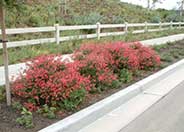
Common name:Red Star Autumn Sage
Botanical name:Salvia greggii 'Red Star'
This shrub will grow 1'-4' tall and 1'-4' wide. It has glossy green leaves with red flowers that bloom from fall to spring.
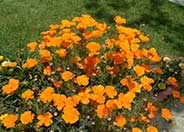
Common name:California Poppy, Golden Poppy
Botanical name:Eschscholzia californica
This small annual (sometimes acts as a perennial) plant will grow to less than 1' tall and has light, small blue green leaves with gold and orange flowers that bloom in spring and summer.
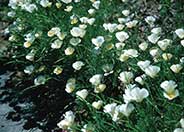
Common name:White California Poppy
Botanical name:Eschscholzia californica 'White'
This annual will grow 6"-24" tall and produces beautiful white blooms surrounded by dark green foliage. It does best in full sun and dry to moist soil.
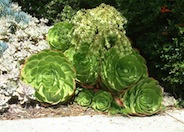
Common name:Parasol Aeonium
Botanical name:Aeonium arboreum
Parasol Aeonium is an upright succulent with rosette leaf clusters. It forms a mound and can be easily propagated by cuttings.
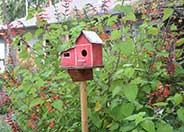
Common name:Tequila Sunrise Sage
Botanical name:Salvia 'Tequila Sunrise'
Tequila Sunrise is a perennial shrub that reaches 3'-6' tall and wide. It needs full sun and medium amount of water. Orange flowers bloom in the spring but this shrub has blossoms most of the year. This shrub will get knocked down to the ground when the first frost arrives in colder climates; however, it will come back vigorously especially if pruned in February or March. Hummingbirds love the flowers.
Designer: Plant Goddess Landscape Design
Photographer: GardenSoft
Maintain a two to four inch layer of mulch on the soil surface to reduce weeds, infiltrate rain water, and reduce compaction.
Fix leaking sprinklers, valves, and pipes.
One broken spray sprinkler can waste 10 gallons per minute - or 100 gallons in a typical 10 minute watering cycle.
Drip and other smart irrigation delivers water directly to roots, allowing no excess water for weeds.